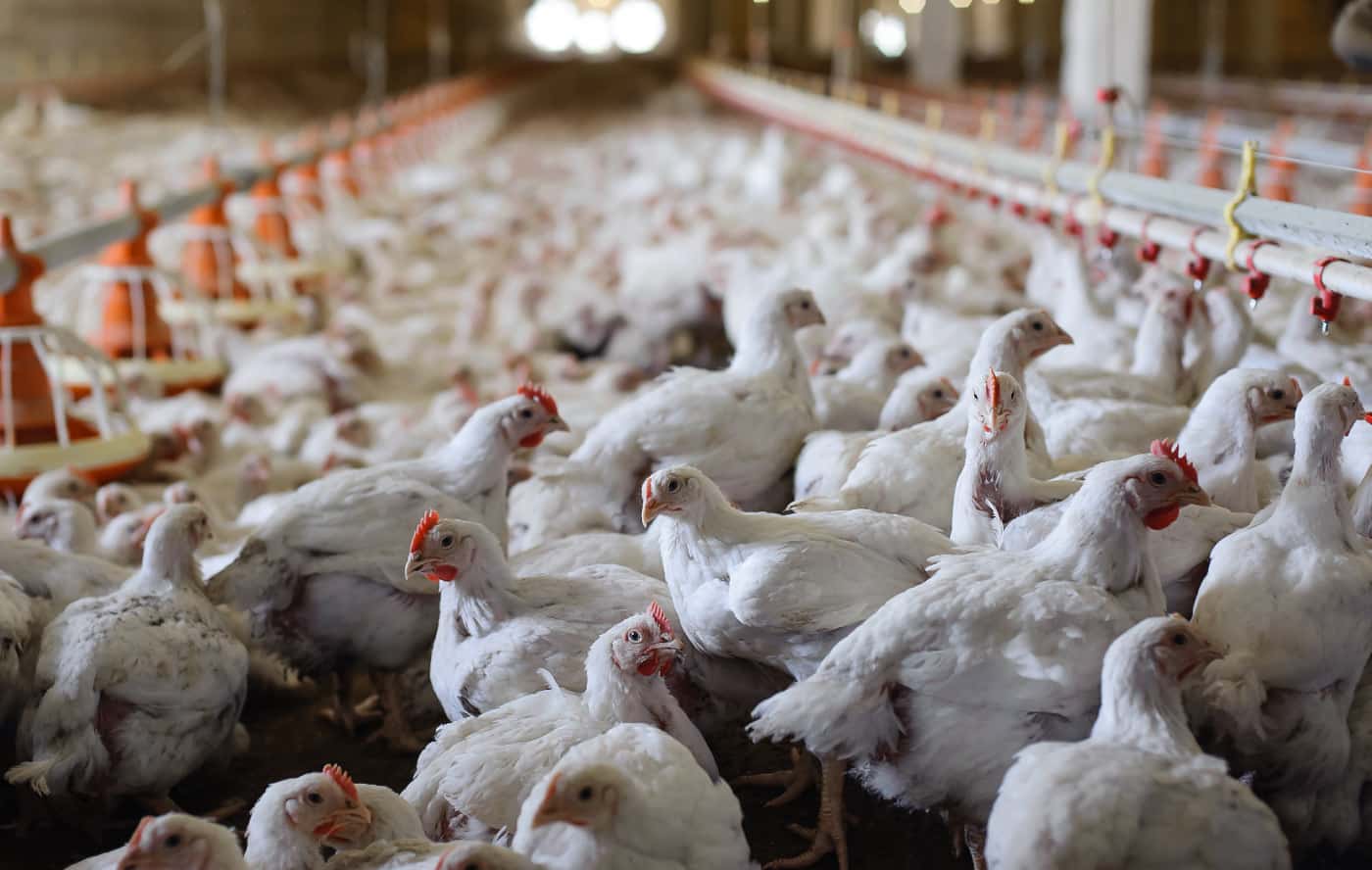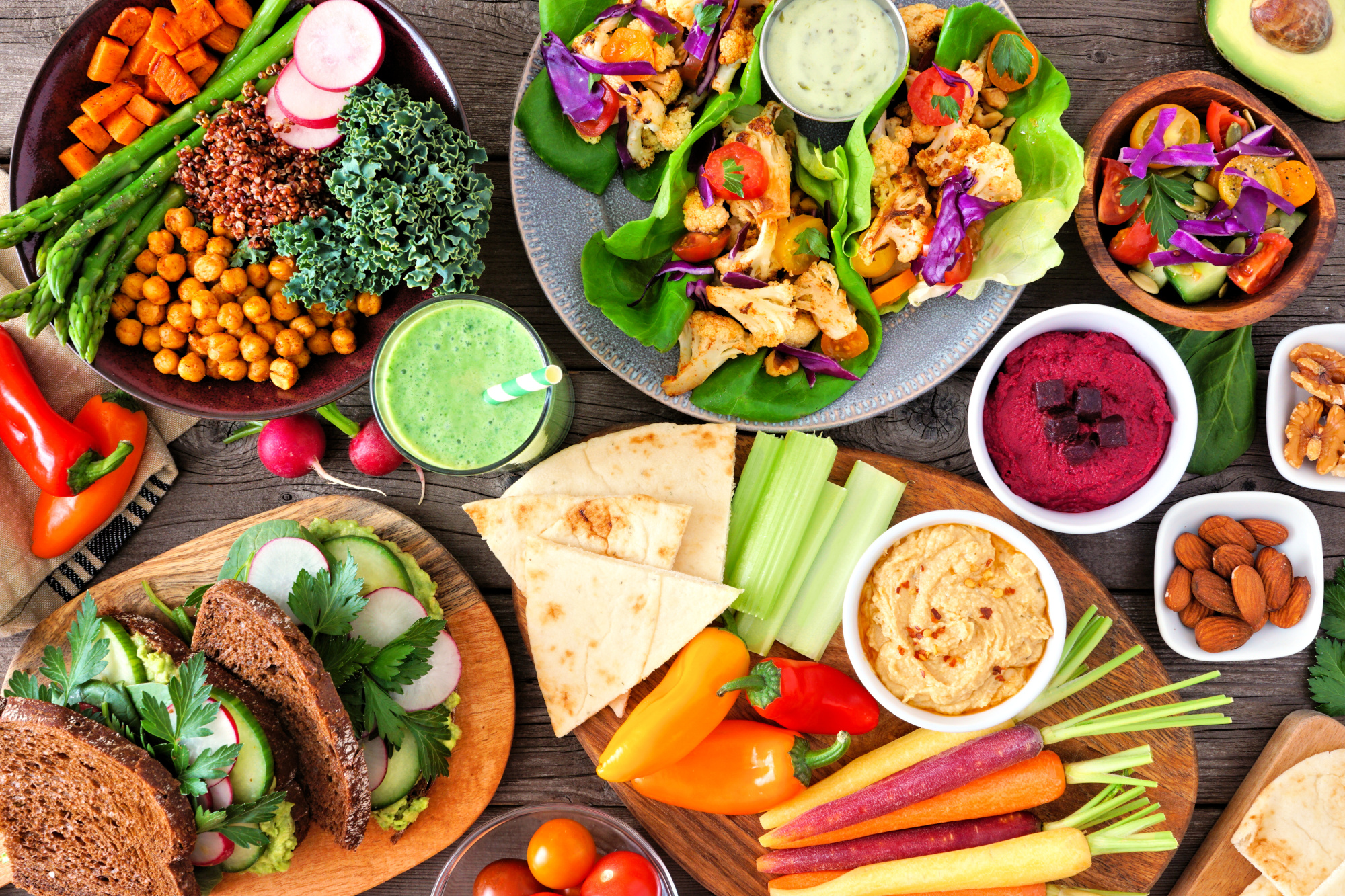In addition to the risks of newly emerging pathogens, there are other factors that can further exacerbate the overall impact of zoonotic pandemics. In our previous blog we explored antimicrobial resistance and the resulting superbugs. We’ll now take a closer look at the second factor – other communicable food-borne diseases.
Read more about antimicrobial resistance
The discovery of antibiotics was one of the key medical achievements of the 20th century. Yet, less than 100 years after Alexander Fleming first discovered penicillin, the world is on the cusp of a post-antibiotic era, with multi-resistant strains of bacteria emerging at alarming rates all around the world.
COMMUNICABLE FOOD-BORNE DISEASES
As well as their involvement in the spread of viruses and the development of AMR, animal-based products also pose other direct health risks that can worsen the impact of a zoonotic pandemic. There is a host of communicable diseases that are associated with the consumption of animal-based products, creating additional risks for individual health and putting additional strain on healthcare systems. WHO estimates that, in 2010, unsafe food caused 600 million cases of food-borne diseases and more than 400,000 deaths.1 While virtually every food contains toxins or pathogens when spoiled, when it comes to food-borne infections of humans, animal-based products deserve special attention. Not only do they harbour some particularly harmful microorganisms, but the sourcing of animal-based products also increases the antimicrobial resistance of these pathogens, rendering them even more dangerous.
Campylobacteriosis – chickens as a reservoir of bacteria
Infection with Campylobacter is one of the most prevalent food-borne diseases, responsible for one out of four cases of diarrhoeal diseases, as well as being the most common cause of human gastroenteritis, globally.2 Chickens are a natural reservoir for Campylobacter. Infected birds carry a very high load of the bacteria in their gastrointestinal tract, which results in contaminated muscles, blood, and bones in the slaughtering and processing stages, which can then lead to the transmission of the pathogens to humans.3 In many parts of the world, Campylobacter shows high levels of resistance to antibiotics such as tetracyclines and fluoroquinolones. The resistance to fluoroquinolones seems to be associated with their use in poultry farming. The campylobacteriosis case-fatality rate fluctuates between <0.01 % and 8.8%.4
Infections with Campylobacter can result in serious long-term impacts on individual health. Among them are Guillain-Barré syndrome (GBS), reactive arthritis, and irritable bowel syndrome. GBS is an autoimmune response that can lead to the deterioration of the nervous system, and is quite severe, with 20% of cases requiring intensive care, and a case-fatality rate of between 3% and 10% in high-income countries.5 Globally, one in three GBS cases is triggered by Campylobacter.
Salmonellosis – eggs and excretion
A pathogen that is more familiar to the general public is Salmonella, which causes salmonellosis. Salmonellosis occurs after consumption of food or water that has been contaminated by the fecal or urinary excretions of animals that are reservoirs of Salmonella.6 7 Salmonella lives naturally in the intestines of many different animals, including rodents, poultry, pigs, and dogs.8 A recent study links the emergence of human-adapted Salmonella to the introduction and intensification of animal farming.9 Salmonella causes typhoid fever (Typhoidal Salmonella) as well as gut distress (non-typhoidal Salmonella).10
Typhoidal Salmonella is responsible for typhoid fever, which constitutes an ongoing burden on developing countries. Between 11 and 21 million people contract typhoid fever annually, and up to 161,000 people die from it.11 Its overall case-fatality rate ranges between 2.5% and 4.5%.12 Non-typhoidal Salmonella (NTS) is one of the main causes of bacterial diarrhoea worldwide and causes around 153 million cases of gastroenteritis globally anually.13 NTS is responsible for the death of more than 50,000 people each year, particularly the very young and the elderly. In 2017, the case-fatality rate for NTS was 14.5% for all ages.14
The emergence of highly virulent and antibiotic-resistant Salmonella has led to greater morbidity and mortality in humans, particularly in the last few decades. A considerable number of multiresistant strains that have emerged in animal farming show resistance to a wide variety of antibiotics, constituting a significant food-safety hazard.15 16
E. coli – friend and foe
The bacteria Escherichia coli (E. coli) normally live in the intestines of humans and other animals. While many strains are harmless and part of a healthy gut microbiome, some can produce toxins that lead to severe diseases.17 18 E. coli human infections occur when consuming food or water contaminated with faeces, with the consequences varying from mild to severe diarrhoea for most of those infected. However, in a tiny percentage of cases, infants may develop haemolytic uraemic syndrome (HUS), a life-threatening disease that causes kidney failure and the destruction of red blood cells.19 20
There are different groups of pathogenic E.coli. One of the best known groups, Shiga toxin-producing E.coli (STEC), causes abdominal cramps and diarrhoea and is primarily transmitted through the consumption of raw or undercooked animal-based products such as meat and milk. Ruminants, mainly cattle, are recognised as its primary natural reservoir.21 Some outbreaks are associated with the consumption of fruit and vegetables such as lettuce, sprouts, and spinach which have been cross-contaminated through the use of manure as fertiliser or via contaminated water.22 STEC is responsible for 90% of HUS cases in infants23 and causes about 2.8 million cases of acute illnesses, annually.24 Although STEC case-fatality ratios are low, its economic impacts are far more severe.25 As with other food-borne diseases, antibiotic resistance in E. Coli is on the rise, with animal farming at the forefront of producing antibiotic-resistant strains.26 27
Food-borne diseases – the risk of eating what is close to us
Looking closely, it is not surprising that many food-borne pathogens are derived from animal-based products. For one thing, humans are evolutionarily much closer to other animals than to plants or fungi. A virus that has adapted to infect a pig’s lung cell requires much less of a shift in its genetic material in order to be able to infect a human lung cell than would a virus originally adapted to infect a plant cell.
Additionally, the processing of animals poses a contamination risk that is difficult to control. Evisceration processes at slaughterhouses can easily lead to the cross-contamination of meat by fecal matter, which may spill when the organs are being removed, resulting in infections of a wide range of organs in humans consuming the contaminated meat. Finally, there is the risk of handling and preparing raw animal-based products at home. Even if the chicken is properly cooked, the tomatoes on the same chopping board might not be.
With every single meal containing animal-based products, the risk of contracting food-borne diseases increases. Although these food-borne diseases do not cause pandemics, they come at a considerable cost to individual health and healthcare systems – and consequently have the potential to worsen the impact of pandemics.
Food and Pandemics Report
By exploring the crucial connection between the current crisis and our animal-based food system, the ProVeg Food & Pandemics Report highlights how our food choices help to create a recipe for zoonotic pandemics.
References
- WHO (2015): WHO estimates of the global burden of foodborne diseases. World Health Organization, Geneva, Switzerland
- WHO (2020): Campylobacter. World Health Organization. Available at https://www.who.int/news-room/fact-sheets/detail/campylobacter. [Accessed: 21.5.2020]
- Hermans, D., F. Pasmans, W. Messens, et al. (2012): Poultry as a Host for the Zoonotic Pathogen Campylobacter jejuni. Vector-Borne and Zoonotic Diseases 12(2), 89–98. doi:10.1089/vbz.2011.067
- World Health Organization, Food and Agriculture Organization of the United Nations & World Organisation for Animal Health. (2013): The global view of campylobacteriosis: report of an expert consultation, Utrecht, Netherlands, 9-11 July 2012. World Health Organization
- World Health Organization, Food and Agriculture Organization of the United Nations & World Organisation for Animal Health. (2013): The global view of campylobacteriosis: report of an expert consultation, Utrecht, Netherlands, 9-11 July 2012. World Health Organization
- WHO Salmonella (non-typhoidal). World Health Organization. Available at https://www.who.int/news-room/fact-sheets/detail/salmonella-(non-typhoidal). [Accessed: 21.5.2020]
- Andino, A. & I. Hanning (2015): Salmonella enterica: Survival, Colonization, and Virulence Differences among Serovars. ScientificWorldJournal. 2015
- CDC (2018): Salmonella Infection. Available at https://www.cdc.gov/healthypets/diseases/salmonella.html. [Accessed: 26.5.2020]
- Key, F. M., C. Posth, L. R. Esquivel-Gomez, et al. (2020): Emergence of human-adapted Salmonella enterica is linked to the Neolithization process. Nature Ecology & Evolution. 4, Nature Publishing Group p.324–333
- Gal-Mor, O., E. C. Boyle & G. A. Grassl (2014): Same species, different diseases: how and why typhoidal and non-typhoidal Salmonella enterica serovars differ. Front Microbiol. 5
- WHO (2018): Typhoid and other invasive salmonellosis Last updated: September 5, 2018. Vaccine-Preventable diseases. Surveillance Standards. Available at https://www. who.int/immunization/monitoring_surveillance/burden/vpd/WHO_SurveillanceVaccinePreventable_21_Typhoid_R2.pdf?ua=1.
- Pieters, Z., N. J. Saad, M. Antillón, et al. (2018): Case Fatality Rate of Enteric Fever in Endemic Countries: A Systematic Review and Meta-analysis. Clin Infect Dis. 67, p.628–638
- CDC Salmonellosis (Nontyphoidal) – Chapter 4 – 2020 Yellow Book -Travelers’ Health. Available at https://wwwnc.cdc.gov/travel/yellowbook/2020/travel-related-infectious-diseases/salmonellosis-nontyphoidal. [Accessed: 25.5.2020]
- Stanaway, J. D., A. Parisi, K. Sarkar, et al. (2019): The global burden of non-typhoidal salmonella invasive disease: a systematic analysis for the Global Burden of Disease Study 2017. The Lancet Infectious Diseases 19(12), 1312–1324. doi:10.1016/S1473-3099(19)30418-9
- V. T. Nair, D., K. Venkitanarayanan & A. Kollanoor Johny (2018): Antibiotic-Resistant Salmonella in the Food Supply and the Potential Role of Antibiotic Alternatives for Control. Foods 7(10), doi:10.3390/foods7100167
- Wang, X., S. Biswas, N. Paudyal, et al. (2019): Antibiotic Resistance in Salmonella Typhimurium Isolates Recovered From the Food Chain Through National Antimicrobial Resistance Monitoring System Between 1996 and 2016. Frontiers in Microbiology 10 doi:10.3389/fmicb.2019.00985
- WHO (2018): E. coli. World Health Organization. Available at https://www.who.int/news-room/fact-sheets/detail/e-coli. [Accessed: 27.5.2020]
- European Centre for Disease Prevention and Control (2017): Facts about Escherichia coli. European Centre for Disease Prevention and Control. Available at https://www.ecdc. europa.eu/en/escherichia-coli-ecoli/facts. [Accessed: 26.5.2020]
- Canpolat, N. (2015): Hemolytic uremic syndrome. Turkish Archives of Pediatrics/Türk Pediatri Arşivi 50(2), 73–82. doi:10.5152/tpa.2015.2297
- Noris, M. & G. Remuzzi (2005): Hemolytic Uremic Syndrome. Journal of the American Society of Nephrology 16(4), American Society of Nephrology, 1035–1050. doi:10.1681/ASN.2004100861
- European Centre for Disease Prevention and Control (2017): Facts about Escherichia coli. European Centre for Disease Prevention and Control. Available at https://www.ecdc. europa.eu/en/escherichia-coli-ecoli/facts. [Accessed: 26.5.2020]
- FAO Preventing E. coli in Food. Food and Agriculture Organisation of the United Nations. Available at http://www.fao.org/fileadmin/user_upload/agns/pdf/Preventing_Ecoli.pdf. [Accessed: 21.5.2020]
- Canpolat, N. (2015): Hemolytic uremic syndrome. Turkish Archives of Pediatrics/Türk Pediatri Arşivi 50(2), 73–82. doi:10.5152/tpa.2015.2297
- Majowicz, S. E., E. Scallan, A. Jones-Bitton, et al. (2014): Global incidence of human Shiga toxin-producing Escherichia coli infections and deaths: a systematic review and knowledge synthesis. Foodborne Pathogens and Disease 11(6), 447–455. doi:10.1089/fpd.2013.1704
- FAO & WHO (2019): Shiga Toxin-producing Escherichia Coli (STEC) and Food: Attribution Characterization and Monitoring Report Microbiological risk assessment series. World Health Organization
- Collignon, P. (2009): Resistant Escherichia coli— We Are What We Eat. Clinical Infectious Diseases 49(2), Oxford Academic, 202–204. doi:10.1086/599831
- Pormohammad, A., M. J. Nasiri & T. Azimi (2019): Prevalence of antibiotic resistance in Escherichia coli strains simultaneously isolated from humans, animals, food, and the environment: a systematic review and meta-analysis. Infection and Drug Resistance 12 1181–1197. doi:10.2147/IDR.S201324










